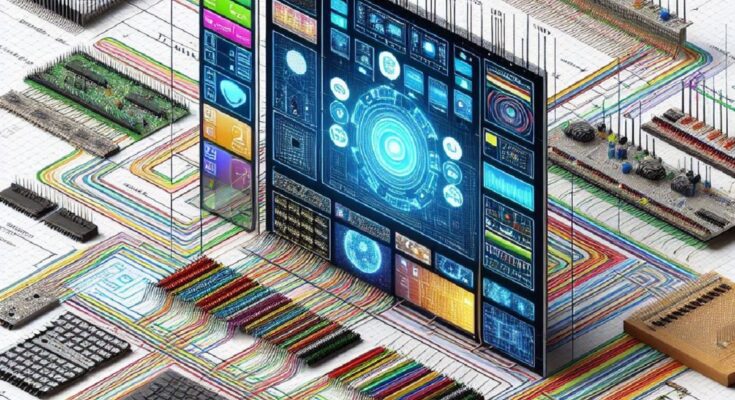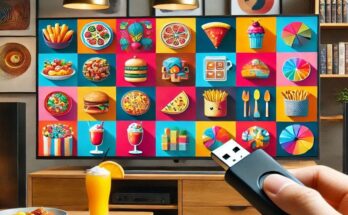Ever wanted to create a dazzling display of lights that can show text, animations, or even custom graphics? Look no further than the captivating world of LED matrices! These electronic wonders are surprisingly accessible for hobbyists and makers. This guide will walk you through the exciting process of building your very own LED matrix display, from gathering the necessary components to writing code that brings it to life.
Demystifying the LED Matrix
An LED matrix is essentially a grid of individual light-emitting diodes (LEDs) arranged in rows and columns. By controlling the on/off state of each LED, we can create patterns, text, and images. These displays come in various sizes, with common options ranging from 8×8 LEDs (perfect for beginners) to much larger configurations that can be used for more complex projects.
Gathering the Essentials
To embark on your LED matrix adventure, you’ll need a few key components:
-
LED Matrix: This is the heart of your project. Popular options include pre-built modules like the MAX7219 or custom-built versions using individual LEDs. Pre-built modules offer a simpler setup process, while building your own matrix with individual LEDs allows for more customization but requires soldering skills.
-
Microcontroller: This tiny computer brain controls the LED matrix. Arduino boards like the Uno or Nano are fantastic choices for beginners due to their ease of use and vast learning resources. The microcontroller will interpret your code and send signals to the LED matrix to light up the LEDs in the desired pattern.
-
Jumper Wires: These handy cables connect the microcontroller to the LED matrix, allowing for information flow. They come in various lengths and colors, making it easier to keep your project organized.
-
Power Supply: Ensure you have a power source that matches the voltage requirements of your LED matrix and microcontroller. A typical setup might involve a USB cable connected to your computer for the Arduino board and a separate power supply for the LED matrix itself, depending on its size and brightness.
-
Breadboard (Optional): This helpful prototyping tool allows for easy connection and testing of components without soldering. Breadboards are great for beginners or for temporary setups as you develop and test your code.
Additional Considerations
-
Resistors: Depending on your LED matrix setup, you might need resistors to limit current and protect the LEDs. Consult your chosen matrix’s datasheet for specific recommendations. Resistors are crucial to prevent damage to your LEDs from excessive current.
-
Enclosure (Optional): To give your project a finished look, consider housing your LED matrix in a custom case. This not only protects your components but also allows you to personalize the appearance of your display.
Power Up Your Creativity: Software & Code
Now that you have the hardware, it’s time to unleash your creativity with software! Here’s where your chosen microcontroller’s programming environment comes in. Popular options like Arduino IDE offer a user-friendly interface for writing code that controls the LED matrix.
Several libraries are available to simplify LED matrix programming, such as the ubiquitous “LED Matrix Library” for Arduino. These libraries provide pre-written functions to easily control individual LEDs, draw lines and shapes, and even display text. Imagine these libraries as toolkits that give you pre-made tools to build your lighting effects and animations without needing to write every single line of code from scratch.
The specific code will vary depending on your chosen platform and library. However, the basic principles remain consistent:
- Include necessary libraries: This allows access to functions for controlling the LED matrix.
- Define pin connections: Specify which pins on your microcontroller connect to the rows and columns of the LED matrix.
- Create functions for drawing: Write functions to turn individual LEDs on or off, draw lines, shapes, and display characters. These functions become the building blocks for your animations and displays.
- Animate your display: Utilize loops and conditional statements to create dynamic lighting effects and animations. Loops allow you to repeat patterns or animations continuously, while conditional statements enable you to change the display based on certain conditions.
Learning Resources
The beauty of the maker community lies in its wealth of shared knowledge. Numerous online resources and tutorials can guide you through specific libraries and coding examples. Popular platforms like YouTube and websites dedicated to Arduino programming offer a treasure trove of information to get you started. There are also online communities where you can connect with other makers and get help with your project.
Beyond the Basics
Once you’ve mastered the fundamentals, the possibilities are endless! Here are some ways to take your LED matrix display to the next level:
-
External Sensors: Add sensors like light or temperature detectors to create displays that react to their environment. Imagine an LED matrix that displays the current room temperature or adjusts its brightness based on the ambient light.
-
Advanced Animations: Pushing the Boundaries of Your LED Matrix
With a solid grasp of the basics, you can delve into the realm of advanced animations, transforming your LED matrix from a simple display into a mesmerizing spectacle of light. Here are some exciting techniques to experiment with:
1. Chasing Patterns and Fire Effects
-
Shifting Rows/Columns: Create captivating chasing patterns by sequentially turning on and off LEDs in rows or columns. Imagine a wave-like effect cascading across the matrix, or a mesmerizing firefly dance.
-
Sinusoidal Movement: For a more organic flow, utilize sine waves to control the brightness of individual LEDs. This technique can generate realistic fire simulations or rippling water effects.
2. Text and Scrolling Effects
-
Advanced Text Features: Go beyond static text displays. Implement features like scrolling text, text animations (like fading in/out), and even multi-color text for added visual impact.
-
Text Scrolling Modes: Explore different scrolling methods like left-to-right, right-to-left, or even bouncing text that changes direction upon reaching the edge of the matrix.
3. Interactive Displays
-
Sensor Integration: Combine your LED matrix with sensors like buttons, accelerometers, or microphones to create interactive displays. Imagine a light show that reacts to your movements or an LED sound meter that visualizes music.
-
User Input: Incorporate user input through buttons or potentiometers to allow viewers to control aspects of the animation, like speed, color, or displayed content.
4. Animations from External Sources
-
Live Data Visualization: Utilize your LED matrix to represent real-time data. Display live stock quotes, weather information, or even sensor readings in a visually appealing way.
-
Animation Libraries & Frameworks: Explore advanced libraries and frameworks specifically designed for LED matrix animations. These tools can offer pre-built effects, animation engines, and even tools to create animations from existing images or video files.
Tips for Advanced Programming
-
Optimization: As your animations become more complex, consider optimizing your code for efficiency to maintain smooth performance. This might involve minimizing redundant calculations or utilizing efficient data structures.
-
Modular Design: Break down your animations into smaller, reusable functions. This modular approach makes code easier to understand, maintain, and reuse in future projects.
Remember, the key to success lies in experimentation and exploration. Don’t be afraid to break the rules and try out new techniques. The online maker community is a valuable resource for inspiration, code examples, and troubleshooting assistance.
With dedication and a dash of creativity, you can transform your LED matrix display into a stunning centerpiece that pushes the boundaries of visual expression.
-




